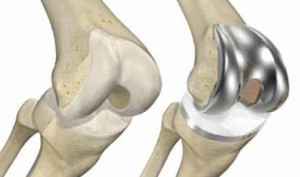Total Knee Replacement
Understanding Total Knee Replacement
Total knee replacement is now arguably the most successful surgical procedure in orthopaedics. It produces a prosthetic joint that closely approximates normal anatomic functions and is relatively painless. More importantly, it allows a return to activity and a freedom from limitation which is most gratifying to patients, families, and surgeons alike.
The most common cause for knee replacement is arthritis. Arthritis is an inflammation of the joint that can cause pain, swelling, stiffness, instability, and deformity of the knee. Avascular necrosis is also another cause for knee replacement. This results in sudden and severe onset of knee pain.
Non-operative treatment is effective in the early stages of both arthritis and avascular necrosis. Minimizing weight bearing by using a cane, crutches, or a walker will help improve the discomfort in the joint. Arthritic pain can also be relieved with the use of anti-inflammatory medication, cortisone injections, and/or physical therapy. These interventions may relieve the pain temporarily or in some cases permanently.
What is a total knee replacement?
Your knee functions very much like a hinge at the junction of two bones, the femur and the tibia. The ends of the bones are covered with a thick cushion of hard, white cartilage. You are given only one coating of this cartilage in your lifetime. If it is damaged or worn away, the underlying bones rub together, producing the pain and inflammation characteristic of arthritis. “Arthritis” simply means an inflammation of a joint causing pain, swelling, stiffness, instability, and often deformity. Severe arthritis interferes with a person’s activities and limits his or her lifestyle.
The primary goal of total knee replacement is to relieve pain. It may also help to restore motion, straighten the limb, improve stability, and improve the function of the joint. In a total knee replacement, the surface of the knee joint is removed, and a variety of artificial implants are substituted to produce an almost normal prosthetic joint. This is accomplished by surgically shaving off the arthritic ends of the bones and replacing them with new metal and plastic surfaces. Your supporting ligaments, tendons, and muscles are retained, and the parts which are surgically implanted mimic the normal anatomy they replace.
Which patients should have total knee replacement?
Painful and arthritic knees often become unstable and untrustworthy, causing falls and other injuries. Climbing stairs, arising from chairs, and extended walking become a challenge. The patient’s independence and self-determination are compromised, and the quality of their life will deteriorate. While most arthritic knees are the result of degenerative osteoarthritis, other conditions such as rheumatoid arthritis, trauma, prior surgeries, contractures, instability, and tumors can be relieved by total knee replacement.

What is the short-term prognosis for total knee replacement?
Patients may stand the day of surgery. They can walk with confidence, climb stairs, and ride in a car by the time of hospital discharge, although usually with the support of walkers, crutches, or canes. Physical therapy and motion exercises are the key to a good outcome. Some swelling, aching, and numbness are normal during this period, and decrease gradually over time.
We believe an exercise program is important in your recovery. The key to a good result is your active participation in physical therapy as well as your home exercise program. The most apparent benefit from total knee replacement is pain relief. Patients continue to gradually improve over time when participating in a regular exercise program.
What is the short-term prognosis for total knee replacement?
Total knee replacement benefits
Total knee replacement complications
The common complications of total knee replacement surgery can now be largely avoided. Each patient receives a thorough pre-operative medical evaluation by an internist as well as routine pre-admission testing.
While phlebitis (or inflammation of the leg veins) is not rare, the incidence of pulmonary emboli (or blood clots to the lungs) has nearly eliminated with the use of support stocking, knee motion machines, early ambulation (walking), and blood thinning medications. To prevent infection in a total knee replacement, we prescribe special antibiotics, conduct expeditious surgery in germ-free operating rooms and all operating room staff wears sterile “space suits.”
Long term complications such as wear, stiffness, or loosening of the parts relate to patient behavior as well as surgical success. These knee problems can usually be improved through revision surgical procedures. Prosthetic implant failures have been seen in high impact activities, and we recommend our patients avoid such activities.
Antibiotics prior to dental procedures
Want to make an appointment?
Phone: (707) 254-7117
Fill out our intake form so we can set up your visit with the correct doctor.
